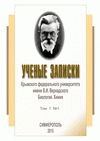Hersonskiy tehnicheskiy universitet
The thermal dependence of the emission of volatile substances of coniferous plants of two species of the genus Juniperus is given: J. isophyllos and J. foetidissima. 100 g of needles of two species of the genus Juniper were collected. Each of the obtained objects was subjected to hydrodistillation with a reflux condenser and a Ginsberg trap. The studies were conducted in triplicate with calculation of the average value and standard deviation for wet and dry plant materials. Separation of volatile emissions collected as essential oils into components was carried out using mass chromatography. Meteorological data for this vegetation period were provided by the Nikitsky Garden Meteorological Station. Volatile substances collected in the form of essential oils from plants of the genus Juniperus have antibacterial, fungicidal and antiviral activities and can be used as biopesticides. It is clearly shown graphically that from the maximum calculated value of the sum of effective temperatures by decades of each month for 2023, the maximum emission is shifted by four decades and falls on the period of ripening of cones for both plant species. This time period turned out to be optimal for collecting BVOC in the form of essential oils from plants of the genus Juniperus for subsequent practical use. In the volatile secretions of J. isophyllos, 32 components were identified, including 2 acyclic with a total content of 2,23 %, 7 monocyclic with a total content of 3,30 %, and 12 bicyclic with a total content of 60,18 %, and 11 sesquiterpenes with a total content of 23,01 %. In the volatile secretions of J. foetidissima, 34 components were identified, among which there were 2 acyclic monoterpenes with a total content of 1,09 %, 7 monocyclic with a total content of 3,20 %, 10 bicyclic with a total content of 31,54 % and one tricyclic with 0,10 %, and 14 sesquiterpenes with a total content of 51,10 %. For both species, two components are predominant: the bicyclic monoterpene α-pinene and the sesquiterpene cedrol, with their content varying for each species. J. isophyllos and J. foetidissima contain 54,12 % and 26,82 % α-pinene, respectively, and 17,44 % and 38,87 % cedrol.
genus Juniperus, emission of volatile substances, sum of effective temperatures, chromatograph mass spectroscopy, mono- and sesquiterpene substances.
1. Tunalier Z. The Composition of essential oils from various of Juniperus foetidissima / Z. Tunalier, N. Kilimer, K. H. C. Baser // Chemistry of Natural Compounds. – 2002. – Vol. 38, № 1. – P. 43–47.
2. Gedik O. Determination of and Cones essential oil components of Juniperus excelsa subsp. excelsa and Juniperus foetidissima Taxa / O. Gedik, Y. Z. Kocabas, O. Cinar // Journal of Applied Sciences. – 2022. – Vol. 7
3. Semerdjieva I. Biological activity of essential oils of four Juniperus species and their potential as biopesticides / I. Semerdjieva, V. D. Zheljazkov, T. Radoukova [at all.] / Molecules. – 2021. – Vol. 26, № 21.





